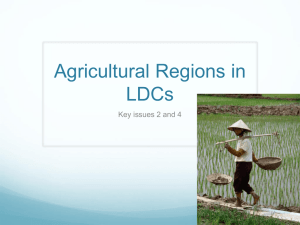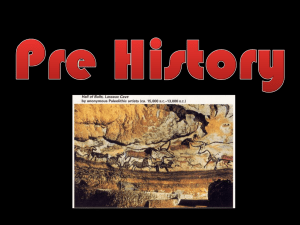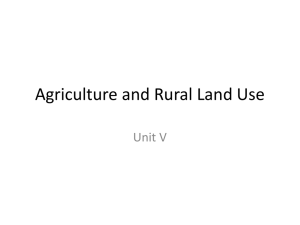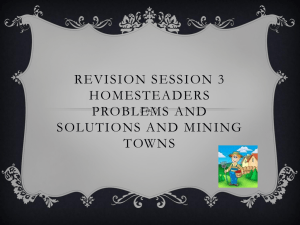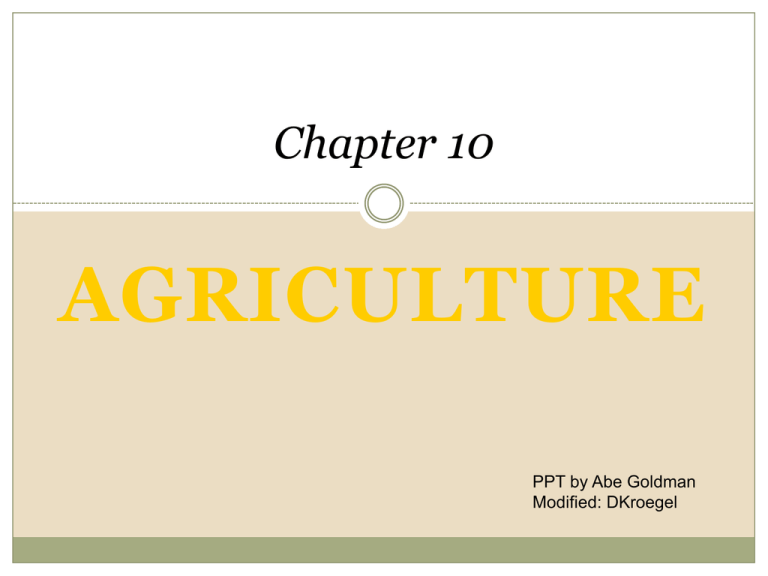
An Introduction to Human Geography
The Cultural Landscape, 8e
James M. Rubenstein
Chapter 10
AGRICULTURE
PPT by Abe Goldman
Modified: DKroegel
Economic Activities
Primary
Raw Materials: Agriculture, mining, fishing, and forestry
Secondary
Manufacturing: capital (for industry) and consumer goods
These three
levels are
often
subdivided
within the
economic
activity
group
“tertiary” as
services may
be utilized
by both
consumers &
producers.
Tertiary
Consumer: retail and personal services; entertainment
Quatrinary
Business/Producer services: trade, insurance, banking,
advertising, transportation and information services
Quinary
Public (government) Services: health, education, research,
transportation, tourism & recreation
Key Issue 1: Where Did Agriculture Originate?
Origins Of Agriculture
Hunters And Gatherers
• Contemporary Hunting And Gathering
Invention Of Agriculture
• Two Types Of Cultivation
Location Of Agricultural Hearths
Location Of First Vegetative Planting
Location Of First Seed Agriculture
Vocabulary
agriculture
crop
vegetative planting
seed agriculture
subsistence agriculture
commercial agriculture
prime agricultural land
agribusiness
• Diffusion Of Seed Agriculture
Classifying Agricultural Regions
Differences Between Subsistence And Commercial Agriculture
•
•
•
•
•
Purpose Of Farming
Percentage Of Farmers In The Labor Force
Use Of Machinery
Farm Size
Relationship Of Farming To Other Businesses
Mapping Agricultural Regions
Agricultural Origins and Regions
Origins of agriculture
Hunters and gatherers
Before the invention of agriculture, all humans probably obtain the food
they needed for survival by hunting for animals, fishing, or gathering
plants (including berries, nuts, fruits, and roots). Hunters and gatherers
lived in small groups, usually fewer than 50 persons, because a larger
number would quickly exhaust the available resources within walking
distance.
TODAY
Estimated 250,000 people living in isolated areas still live as hunter-gatherers
Arctic, and the interiors of Africa, South America and Australia
Invention of agriculture
Agriculture is the deliberate modification of Earth’s surface through
cultivation of plants and rearing of animals to obtain sustenance or
economic gain.
Dates back some 10 to 12 thousand years
Location of Agricultural Hearths
Location of
agricultural hearths
Vegetative planting
(aka root cropping) is the
reproduction of plants by
direct cloning from
existing plants, such as
cutting stems and dividing
roots [Cassava (manioc or
yucca), yams, sweet
potatoes]
Vegetative Planting Hearths
Fig. 10-1: There were several main hearths, or centers of origin, for vegetative crops
(roots and tubers, etc.), from which the crops diffused to other areas.
Agricultural Origins and Regions
Location of
agricultural
hearths
Seed agriculture
the reproduction of
plants through annual
planting of seeds that
result from sexual
fertilization
rice
millet
sorghum
flax
barley
wheat
Seed Agriculture Hearths
Fig. 10-2: Seed agriculture also originated in several hearths and diffused
from those elsewhere.
Carl Sauer: Location of Agricultural Hearths
Agriculture probably did not originate in one location, but
began in multiple, independent hearths, or points of origin.
From these hearths agricultural practices diffused across
Earth’s surface.
Vegetative planting
Southeast Asia (mainland) diffused to China, Japan, India and Southwest Asia,
Africa and the Mediterranean
West Africa
northwestern South America diffused to Central America and eastern South
America
Seed agriculture
western India (Pakistan/Indus River)
Northern China
Ethiopia
Carl Sauer: 11 areas of agriculture innovations
Agriculture probably did not originate in one location, but began in multiple,
independent hearths, or points of origin. From these hearths agricultural practices
diffused across Earth’s surface.
Animal Domestication
The best animals to farm are large, plant eating mammals. Over the years,
humans have probably tried to domesticate all of them, usually without
success. Despite repeated efforts, Africans have never domesticated the
elephant.
Animals which make suitable candidates for domestication have the
following characteristics:
start giving birth in their first or second years
have one or two offspring a year (so their productivity is high)
behaviorally they need to be social animals (males, females and the young live
together as a group)
get along with humans
internal social hierarchy
which means that if humans can control the leader, they will also gain control of
the whole herd.
Diamond counted 148 different species of wild, plant eating, terrestrial animals
that weigh over 100 pounds. Of those, we have only successfully farmed
for any length of time –just 14. They are: goats, sheep, pigs, cows,
horses, donkeys, Bactrian camels, Arabian camels, water buffalos,
llamas, reindeers, yaks, mithans and Bali cattle. All but one [llamas of
South America] of these animals are native to Asia, North Africa and Europe.
The Big Four livestock animals: cows, pigs, sheep and goats were native to the
Middle East.
U.S. Farms by Region
The number of farms
in the United States in
2008 is estimated at
2.2 million, 0.2 percent
fewer than in 2007.
Total land in farms, at
919.9 million acres,
decreased 1.56 million
acres, or 0.2 percent, from
2007.
The average farm size
was 418 acres,
unchanged from the
previous year. The decline
in the number of farms
and land in farms
reflects a continuing
consolidation in farming
operations and diversion
of agricultural land to
nonagricultural
uses.
USDA 2008 Report
NOTE: Map at left from 2002 but change in
farms from 2002 to 2008 would show little
visible change on the map.
Classifying Agricultural Regions
LDCs = subsistence agriculture
MDCs = commercial agriculture
Subsistence vs. commercial agriculture
Subsistence agriculture is the production of food primarily
for consumption by the farmer’s family
Commercial agriculture is the production of food primarily
for sale off the farm
Practice
Subsistence
agriculture
Commercial
agriculture
Area
Purpose
LDCs
Personal
consumption
MDCs
Grow crops
and raise
animals
primarily for
sale off the
farm for profit
Labor force
On average 55%
of workforce
engaged in
farming
Machinery
Farm size
Off farm contact
Human and
animal powered
tools
Very small
Occasional surplus sold
agribusiness – farms one
Mechanized farm
On average 5% of
Large
part of a large food
machines,
workforce
[US average in
production industry
computer
engaged in
2008 = 418
including food processing,
technology and
farming
acres]
packaging, sorting,
science
distributing, and retailing
Labor Force in Agriculture
Fig. 10-3: A large proportion of workers in most LDCs are in agriculture, while only a small
percentage of workers in MDCs are engaged in agriculture.
Tractors, per Population
Fig. 10-4: Tractors per 1,000 people. Use of machinery is extensive in most MDC
agriculture, but it is much less common in LDCs.
Farmland Loss in Maryland
Fig. 10-1-1:
Overlaps of soil quality,
environmental and
cultural features, and
population growth may
show areas of greatest
threat of farmland loss in
Maryland.
Baltimore
Washington
DC
Baltimore and
Washington DC
population concentrations
have merged over time.
A serious problem in the United States has been the loss of the most productive
farmland, known as prime agricultural land, as urban areas sprawl into the
surrounding countryside.
Classifying Agricultural Regions
Mapping agricultural regions
World Agricultural Regions: Derwent Whittlesey, 1936
11 main agricultural regions
5 important to LDCs
6 important to MDCs
Climate influences the crop that is grown and/or animals raised
Relationship exists between climate and agriculture
Dry climate often equates to livestock ranching rather than farming
Culture influences agriculture
Hog (pig/swine) production low to nonexistent in predominantly Muslim
(and Jewish) regions due to religious taboo on pork.
World Agriculture Regions
Fig. 10-5a: Locations of the major types of subsistence and commercial agriculture.
World Climate Regions
Fig. 10-5b: Simplified map of the main world climate regions (see also Fig. 2.2).
Key Issue 2: Where Are Agricultural Regions in LDCs?
Shifting Cultivation
Characteristics Of Shifting Cultivation
Vocabulary
shifting cultivation
slash-and-burn agriculture
• The Process Of Shifting Cultivation
swidden
• Crops Of Shifting Cultivation
pastoral nomadism
• Ownership In Use Of Land In Shifting Cultivation
transhumance
pasture
Future Of Shifting Cultivation
intensive subsistence agriculture
Pastor Nomadism
sawah
Characteristics Of Pastoral Nomadism
paddy
• Choice Of Animals
chaff
threshed
• Movements Of Pastoral Nomads
winnowed
The Future Of Pastoral Nomadism
hull
Intensive Subsistence Agriculture
wet rice
double cropping
Intensive Subsistence With Wet Rice Dominant
crop rotation
Intensive Subsistence With Wet Rice Not Dominant
Major types subsistence agriculture:
Shifting cultivation
Intensive Subsistence Agriculture
with/without wet rice dominance
Pastoral Nomadism
Plantation
Major types of commercial agriculture:
Mixed Crop & Livestock Farming
Dairy Farming
Grain
Livestock Ranching
Mediterranean – horticulture
Commercial Gardening
Plantation
World Per Capita GDP
Fig 9.2 (TBp301)
Agriculture in Less Developed Countries
Shifting cultivation
cultivation vs. agriculture = small scale vs. large scale
Characteristics of shifting cultivation
Clear (slash-and-burn agriculture) vegetation from land
Cleared land = swidden
Potash (potassium) = fertilizer from burned debris
Plant crops for a few years then leave fallow
Land fertile for 3 or less years
Native vegetation returns; soil recovery slow takes years
Villages may expand or move due to depletion of soil
Crops vary by local custom and taste and mostly subsistence agriculture
Southeast Asia: rice; South America: maize, manioc; Africa: millet, sorghum
Varied crops planted for use by one family or community
Land often owned by community rather than individuals
Requires more land per person
¼ of world’s land area cultivated by 5% of population
Agriculture in Less Developed Countries
Future of shifting cultivation
Replaced by cash crops, ranching and logging
Eliminating difficult as farming part of culture
Pressure on rain forest countries to curb use
Agriculture in Less Developed Countries
Pastoral nomadism
form of subsistence agriculture based on the herding of domesticated
animals
Arid/semiarid regions of Africa and SW Asia and Central Asia
15 million people on 20% of land area
Characteristics of pastoral nomadism
Milk, skin/hair for clothing or tents
Still eat mostly grains
part community farms or trade animal product
Often in conjunction with agriculture
Choice of animals: cultural and practical
Animal
Numbers
Pros
Cons
Camel
10 – 25
Infrequent watering, heavy loads, fast
Attracts flies, sleeping sickness, long gestation period
Goat
Sheep
25 – 60
25 – 60
Tough, agile, eats any vegetation
wool
More water than camel
Slow moving, affected by climate change
Agriculture in Less Developed Countries
Movements of Pastoral Nomads
Territorial
Intimate knowledge of the terrain
Climate and political instability alter routes
Transhumance (seasonally migratory)
Future of pastoral nomadism
Declining practice… once considered the cultural stage between
hunting/gathering and farming settlement
Now… Offshoot of sedentary agriculture
Practical method for drier climates
Communication technology eliminates some of their power/usefulness
Low population density practice
Forced end by “progress”… population, space and lifestyle changes
Agriculture in Less Developed Countries
Intensive subsistence agriculture
¾
of world population lives in LDCs
East, South and Southeast Asia
China – efficient and very small lots
Labor intensive (no $ for machines)
Efficient land use
Intensive subsistence with wet rice dominant
Intensive subsistence with wet rice not dominant
World Rice Production
Fig. 10-6: Asian farmers grow over 90% of the world’s rice. India and China alone
account for over half of world rice production.
Key Issue 3: Where Are Agricultural Regions in MDCs?
Mixed Crop And Livestock Farming
Characteristics Of Mixed Crop And Livestock Farming
•
Crop Rotation Systems
Choice Of Crops
Dairy Farming
Why Dairy Farms Locate Near Urban Areas
Regional Differences In Dairy Products
Problems For Dairy Farmers
Grain Farming
Grain-Farming Regions
Importance Of Wheat
Livestock Ranching
Cattle Ranching In U.S. Popular Culture
•
•
Fixed Location Ranching
•
•
Range Wars
Changes In Cattle Breeding
Ranching Outside The United States
Mediterranean Agriculture
Mediterranean Crops
Commercial Gardening And Fruit Farming
Plantation Farming
Beginning Of U.S. Cattle Ranching
Transporting Cattle To Market
Vocabulary
cereal grain
milkshed
grain
winter wheat
spring wheat
reaper
combine
ranching
horticulture
truck farming
plantation
Mixed Crop and Livestock Farming
Characteristics Of Mixed Crop And Livestock Farming
Most common form of commercial agriculture in the United States Great Plains
Integration of crops and livestock
Crops fed to animals (little sold); Manure used to fertilize crops
¾ income derived from animal products – these, milk and eggs
Crop seasonal labor – livestock year round
• Crop Rotation Systems
2 or more crops rotated with one round fallow
Maintains field fertility mutrients one crop takes another will replace
Two fields
Three fields
Four fields
Year 1
Field A
Cereal grain
Field B
fallow
Field C
Field D
Year 2
Fallow
Cereal grain
Year 1
Winter cereal
Spring cereal
Fallow
Year 2
Spring cereal
Fallow
Winter cereal
Year 3
Fallow
Winter cereal
Spring cereal
Year 1
Root crop
Cereal
“rest” crop
cereal
Year 2
Cereal
“rest” crop
Cereal
Root crop
Year 3
“rest” crop
Cereal
Root crop
Cereal
Year 4
Cereal
Root crop
Cereal
“rest” crop
n/a
Result
n/a
3 crops per field over 6 years
n/a
4 crops per field over 6 years
3 crops per field over 4 years
Choice Of Crops
• Corn Belt – Ohio to the Dakotas
Corn (most common) used for livestock feed, or human consuption including oil, margarine, etc.
• Soybean (2nd choice)
Tofu (Japan and China), processed food additive and animal feed
World Corn (Maize) Production
Fig. 10-7: The U.S. and China are the leading producers of corn (maize) in the world.
Much of the corn in both countries is used for animal feed.
World Milk Production
Fig 10-8: Milk production reflects wealth, culture, and environment. It is usually high in
MDCs, especially production per capita, and varies considerably in LDCs.
Dairy & Grain Farming
Dairying most important commercial agriculture near large urban areas (20% of agriculture $$ output)
Why Dairy Farms Locate Near Urban Areas
•
•
Regional Differences In Dairy Products
•
•
Farmers far from urban centers usually sell to diary product (cheese, butter, etc) processors
NE USA milk sold to urban center consumers; farther west (Wisconsin) milk is all processed
Problems For Dairy Farmers
•
•
•
Milkshed close to market due to perishability of milk products
Proximity to market less important now due to transportation options
Declining revenues and rising costs
Labor intensive, cows milked twice daily
Winter feed expenses
Grain Farming
•
•
Grain-Farming Regions
•
•
•
•
•
Some form of grain major on most farms – wheat most important
Meant for human consumption (unlike integrated farming)
US largest grain producers; other large scale: Canada, Australia, Argentina, France and the UK
Winter wheat Belt: Kansas, Colorado and Oklahoma
Spring wheat Belt: the Dakotas, Montana and southern Saskatchewan (Canada)s 2/3 of US wheat
Palouse in Washington State
Heavily mechanized planting and harvesting (combine) crop
Importance Of Wheat
•
•
•
World’s leading export crop
North American prairies the “Breadbasket” producing ½ world exports of wheat
Economic and political strength for the US
Dairy Production in the U.S.
Fig. 10-9:
Milk production (top
right) is widely
dispersed because of
its perishability, though
there are areas with
greater production.
As a whole the US
produces tons of milk
(left).
Cheese production
(bottom right) is far
more concentrated.
World Wheat Production
Fig. 10-10: China is the world’s leading wheat producer, but the U.S. and Canada account
for about half of world wheat exports.
Livestock Ranching
Livestock Ranching
•
Cattle Ranching In U.S. Popular Culture
•
•
Adapted to semi-arid or arid lands of MDCs
Taught to us in cowboy films
Beginning Of U.S. Cattle Ranching
First brought to the Americas by Columbus on his second voyage
Cattle ranching migrated west with the settlers
Transporting Cattle To Market
Best market prices in Chicago – birth of the cattle drive
Cattle transported “on the hoof” to railroad along the Chisholm Trail then
to slaughter houses
Major cattle ranching center in Texas
Fixed Location Ranching
Conflict between ranchers and farmers over range rights
Early cattle ranchers in the West owned cattle but little land
Range Wars
US government sold land to farmers who put up fences which angered
ranchers
Ranchers were compelled to buy or lease land
Today 60% of cattle grazing occurs on land leased from the US
government
Changes In Cattle Breeding
Fig. 10-11: The Chisholm Trail became
Switch from Longhorn (sturdy for cattle drives but poor meat quality) to
famous as the main route
Hereford (superior meat but not suited to long-range drives) cattle
for cattle drives from Texas
Change in cattle breed ended trail drives
to the railheads in Kansas.
Livestock fattening farms/feed lots are stop before slaughter housess
•
•
Meat Production on Ranches
Ranching outside of the US
Fig. 10-12:
Cattle,
sheep, and
goats are
the main
meat
animals
raised on
ranches.
Livestock Ranching
Mediterranean Agriculture
Mediterranean Crops
Commercial Gardening And Fruit Farming
Plantation Farming
Key Issue 4: Why Do Farmers Face Economic Difficulties?
Issues For Commercial Farmers
Access To Markets
•
•
•
Overproduction In Commercial Farming
Sustainable Agriculture
•
•
•
Sensitive Land Management
Integrated Crop Livestock
Forest Fallow
Bush Fallow
Short Fallow
Annual Cropping
Multi Cropping
Subsistence Farming And International Trade
•
Drug Crops
Strategies To Increase Food Supply
Increase Food Supply By Expanding Agricultural Land
Increase Food Supply Through Higher Productivity
Increase Food Supply Of Identifying New Food Sources
•
•
•
U.S. Government Policies
Issues For Subsistence Farmers
Subsistence Farming And Population Growth
•
•
•
•
•
Von Thünen’s Model
Example Of Von Thünen’s Model
Application Of Von Thünen’s Model
Cultivate Oceans
Higher-Protein Cereals
Improve Palatability Of Rarely Consumed Foods
Increase Food Supply By Increasing Exports From Other Countries
Africa’s Food Supply Prices
Vocabulary
sustainable agriculture
ridge tillage
fallow
forest fallow
bush fallow
short fallow
annual cropping
Multicropping
desertification
green revolution
Issues for Commercial Farmers
Access
To Markets
• Von Thünen’s Model
Location, location, location
Balance of income to expenses
Proximity to market
• Example Of Von Thünen’s Model - see TBp356
Application of Von Thünen’s Model
The Von Thünen model of agricultural land use was created by
farmer and amateur economist Johann Heinrich Von Thünen
(1783-1850) in 1826 (but it wasn't translated into English until
1966). Von Thünen's model was created before industrialization
and is based on the following limiting assumptions:
The city is located centrally within an "Isolated State" which is
self sufficient and has no external influences.
The Isolated State is surrounded by an unoccupied wilderness.
The land of the State is completely flat and has no rivers or
mountains to interrupt the terrain.
The soil quality and climate are consistent throughout the State.
Farmers in the Isolated State transport their own goods to market
via oxcart, across land, directly to the central city. Therefore,
there are no roads.
Farmers act to maximize profits.
Von Thünen
Model of Agricultural Land Use
Fig. 10-13: Von Thünen’s model shows how distance from a city or market affects the
choice of agricultural activity in (a) a uniform landscape and (b) one with a river.
In an Isolated State with the foregoing statements
being true, Von Thünen hypothesized that a pattern
of rings around the city would develop. There are
four rings of agricultural activity surrounding the city.
Dairying and intensive farming occur in the ring
closest to the city. Since vegetables, fruit, milk and
other dairy products must get to market quickly,
they would be produced close to the city
(remember, we didn't have refrigerated oxcarts!)
Timber and firewood would be produced for fuel and
building materials in the second zone. Before
industrialization (and coal power), wood was a very
important fuel for heating and cooking. Wood is very
heavy and difficult to transport so it is located as
close to the city as possible.
The third zone consists of extensive fields crops
such as grains for bread. Since grains last longer
than dairy products and are much lighter than fuel,
reducing transport costs, they can be located further
from the city.
Von Thünen continued
Ranching is located in the final ring surrounding the central city. Animals
can be raised far from the city because they are self-transporting. Animals
can walk to the central city for sale or for butchering.
Beyond the fourth ring lies the unoccupied wilderness, which is too great a
distance from the central city for any type of agricultural product.
Even though the Von Thünen model was created in a time before
factories, highways, and even railroads, it is still an important model in
geography. The Von Thünen model is an excellent illustration of the
balance between land cost and transportation costs. As one gets closer to
a city, the price of land increases. The farmers of the Isolated State
balance the cost of transportation, land, and profit and produce the most
cost-effective product for market. Of course, in the real world, things don't
happen as they would in a model.
http://geography.about.com/od/urbaneconomicgeography/a/vonthunen.htm
Issues For Commercial Farmers
Overproduction In Commercial Farming
• Food demand inelastic… due to limit of consumption
• Efficiency can work against the farmer
Efficiency of agriculture practices increases yields (supply) which can cause surplus
which decreases market price
• U.S. Government Policies
Discourages production of surplus crops
• Encourages planting of fallow crops
Government subsidies ≈$10 billion annually
• paid to farmers – difference between target price and market price if less then the target price
• Government purchases surplus product and sells or donates to foreign governments
Sustainable Agriculture
• Sensitive Land Management
Ridge tillage (see next slide)
• Integrated Crop Livestock
Feed crops grown for farm livestock to graze on
Forgo purchase of feed for livestock
Ridge Tillage
Allelopathy - suppression of growth of a plant by a toxin
(“Roundup-Ready” seeds) released from a nearby plant of
the same or another species.
Ridge tillage resembles contemporary
and traditional cropping systems in
which plants grow on a hill or bund.
Cotton, for example, is often grown on
ridges for purposes of irrigation. In ridge
tillage the ridges are a product of
cultivation of the previous crop and are
not tilled out after harvest. The planter
may remove part of the ridge top, but
before planting there is no tillage. This
provides potential advantages in soil
conservation and weed management.
http://www.pfi.iastate.edu/OFR/RT_description.htm
Grain Importers and Exporters
Fig. 10-15: Most countries are net importers of grain. The U.S. is the largest net exporter.
Issues For Subsistence Farmers
Subsistence Farming And Population Growth
Ester Boserup – relationship between population growth and types of subsistence farming
As population increases the intensity of agricultural practices increases.
Type
Forest Fallow
Bush Fallow
Short Fallow
Annual Cropping
Multicropping
Time Used for
Crops
Two years
≤ 8 years
≈2 years
Every year
All year
Time Left Fallow
20+ years
≤10 years
≈2 years
Few months
Never
Fallow period growth
Forest grows back
Bushes and small trees grow back
Wild grasses grow back
Legumes and roots planted during fallow period
Several crops grow all year
Subsistence Farming And International Trade
Conundrum – LDCs need money to modernize but are focused on survival
• Workers plant “cash crops” to earn foreign money but money often used to support efforts to earn
the money and so modernization is slow at best
Drug Crops
• “cash crops” chosen often plants from which illegal drug are derived
Strategies to Increase Food Supply
Increase Food Supply By Expanding Agricultural Land
Need more food… cultivate more land
• Historical method of increasing production
(2005) 11% of Earth land area devoted to agriculture
Desertification an issue in LDCs
• Some 104,000 square miles once arable land lost each year
Excessive agriculture stresses the land
Man-made irrigation systems w/poor drainage threaten other
regions with too much water
Urban sprawl
Desertification Hazard
Fig. 10-14: The most severe desertification hazards are in northern Africa, central Australia, and the
southwestern parts of Africa, Asia, North America, and South America.
Strategies to Increase Food Supply
Increase Food Supply Through Higher Productivity
Threat of population out growing food supply (1960s) encouraged innovation (1970-80s)
• Enter… the GREEN REVOLUTION – the third Agricultural Revolution (1930s – present)
Introduction of new higher-yield seeds (research started in 1950s)
The expanded use of fertilizers
• Understand how fertilizers work… the nutrient components– nitrogen, phosphorus and potassium
• Nutrients not readily or uniformly available everywhere
Increase Food Supply by Identifying New Food Sources
•
•
•
Cultivate Oceans
¾ of Earth surface
Caution – overfishing an issue (65 of 153 species monitored overfished)
200 mile economic zone off shore of each countrys
Higher-Protein Cereals
Genetically Modified (GM) grains to increase protein content
Vitamin fortified processed foods are limited help to LDCs as they are subsistence farmers
Improve Palatability Of Rarely Consumed Foods
Culture/religion play a role in food choices
Changing perception and improving taste are not easy
Increase Food Supply By Increasing Exports From Other Countries
•
•
US largest wheat/corn grain exporter currently with Canada, Australia and Argentina following
Potential for international increase in exportation but slow moved
Africa’s Food-Supply Crisis
Sub-saharan Africa from the Sahel
The Sahel, which is south of the Sahara, frequently faces
drought and food shortages, as does the Horn of Africa.
south to South Africa
70% of Africans have too little to eat
Expect to get worst before it gets
better
Per person food production down by
< 20%
Severe in “Horn of Africa” – Somalia,
Ethiopia and Sudan
Population increases creates land
scarcity and intensive agriculture
which stresses the land
Unusual droughts lasting decades
Stagnate economies
Sources
About.com, Von Thunen Model;
http://geography.about.com/od/urbaneconomicgeography/a/vonthunen.htm
Rubenstein, James M., The Cultural Landscape An Introduction to Human Geography,
8th Edition, Pearson Prentice Hall, New Jersey, 2005
De Blij, Harm J., Human Geography People Place and Culture, 8th Edition, Wiley &
Sons, 2007
National Geographic Video: Diamond, Jared, Guns, Germs and Steel
USDA 2002 Census of Agriculture
http://www.nass.usda.gov/research/atlas02/index.html
USDA Farms, Land in Farms, and Livestock Operations 2008 Summary, February 2009
http://usda.mannlib.cornell.edu/usda/nass/FarmLandIn//2000s/2009/FarmLandIn02-12-2009.pdf
Maps of the World, World Climate Map; http://www.mapsofworld.com/worldmaps/world-climate-map.html
Practical Farmers of Iowa, What is Ridge-Till?
http://www.pfi.iastate.edu/OFR/RT_description.htm


